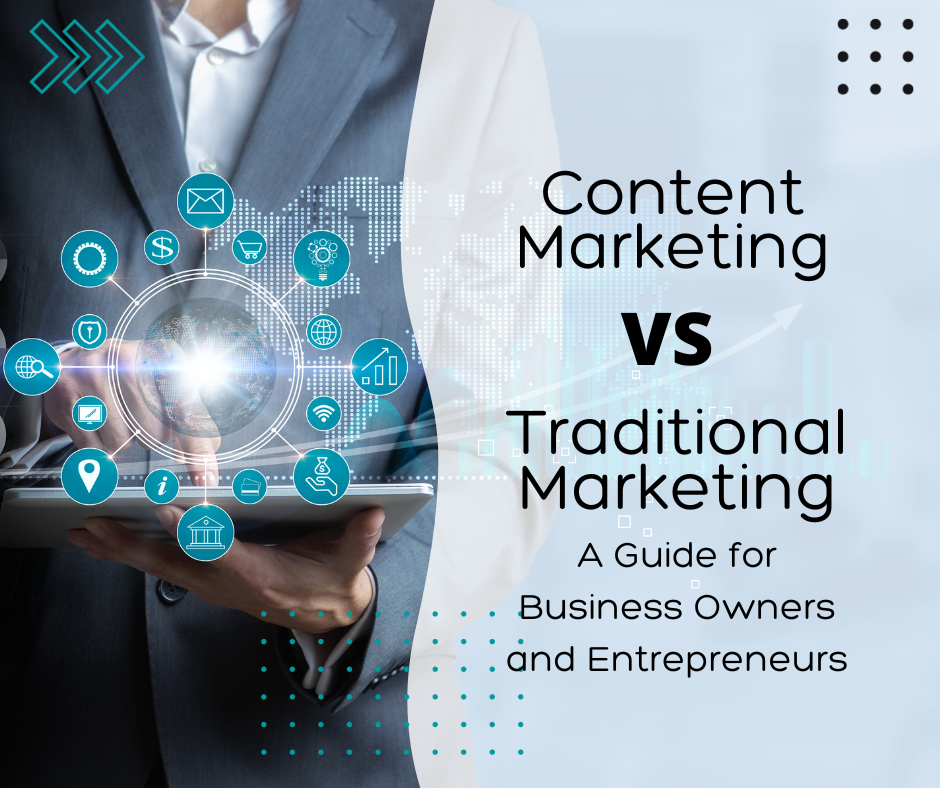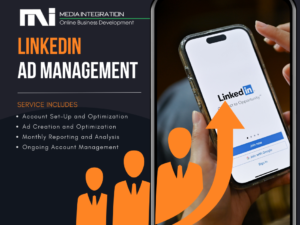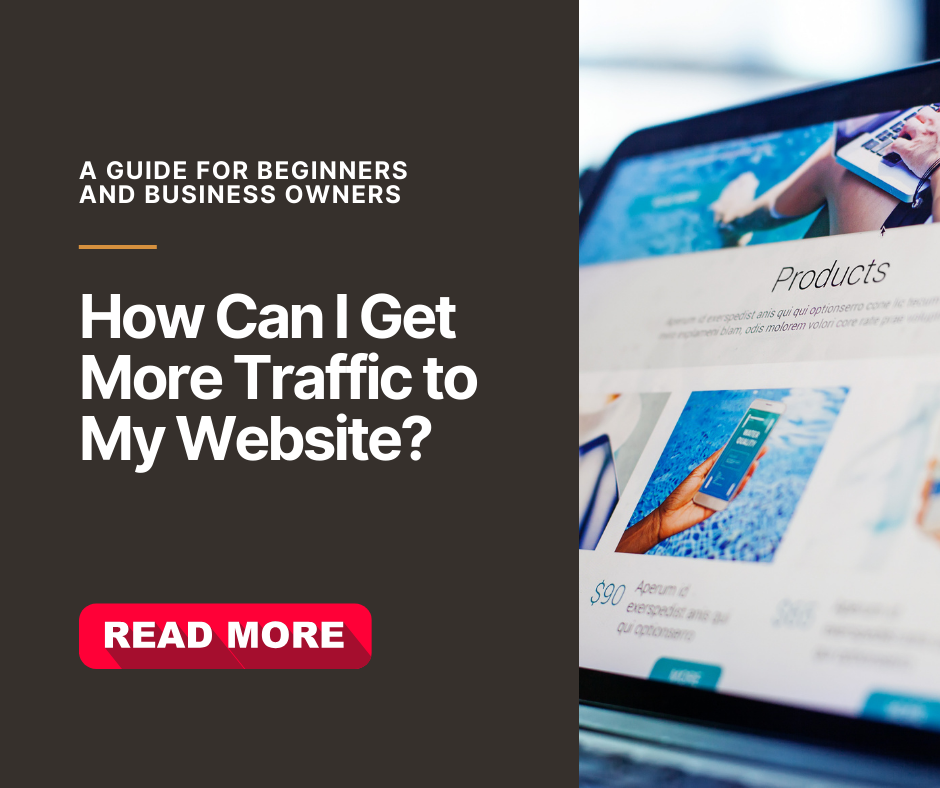Navigating the Dynamic World of Marketing
In the ever-evolving business landscape, one of the most pressing debates among entrepreneurs and business owners is the efficacy of content marketing versus traditional marketing. This conversation is anything but trivial; it entails making crucial decisions that will shape your brand’s perception, engage customers, and ultimately impact your profits. With rapid technological advancements and shifts in consumer behaviour, the ‘set it and forget it’ approach from the past no longer serves its purpose. Today’s dynamic environment calls for a nuanced understanding of various marketing channels.
So, what exactly are content and traditional marketing, and how do they differ? Which strategy provides a better return on investment (ROI)? And, most importantly, which is the right fit for your business? This post explores the pros, cons, and differences between content and traditional marketing. The insights are supported by real-world examples and statistics, offering actionable advice for making informed marketing decisions.
Now, let’s explore which strategy—content or traditional marketing—best fits your business goals.
Content Marketing: Beyond the Sales Pitch
Content marketing is often considered the go-to approach for long-term growth in modern marketing. This strategy focuses on creating valuable and engaging content to solve your audience’s problems or answer their questions. The content could range from blogs, videos, and podcasts to social media posts.
Take, for example, HubSpot, a company that offers inbound marketing software. They are a quintessential example of content marketing done right. HubSpot provides software, articles, templates, and free courses on inbound marketing, SEO, and CRM. This approach establishes them as an authority in their field and generates organic traffic and leads. According to HubSpot’s reports, their content marketing efforts contribute 75% of their overall lead generation1.
Another striking example is Airbnb’s online magazine “Airbnbmag.” Rather than just advertising vacation rentals, the magazine offers articles on travel destinations, tips, and community stories. This content strategy enhances user experience and indirectly boosts business by inspiring travel.
The stats favour this approach, too. Per findings from the Content Marketing Institute, it costs 62% less but yields three times more leads[^2^]. Thus, content marketing is not about the hard sell; it’s about building a relationship with your customers. They come for the information and stay for the quality, eventually becoming loyal consumers of your product or service. With this understanding of content marketing, let’s explore its counterpart: traditional marketing.
Traditional Marketing: The Transactional Approach
In stark contrast to the relationship-building focus of content marketing, traditional marketing is generally more transactional. Traditional marketing relies on channels such as TV ads, billboards, and print media to deliver direct sales messages, encouraging immediate actions like purchases or sign-ups.
Coca-Cola: The Success Story in Traditional Marketing
One company that epitomizes the successful use of traditional marketing is Coca-Cola. Their TV ads, often tied to emotional themes like happiness and togetherness, are a staple during high-profile events like the Super Bowl. These ads aim to create brand awareness on a massive scale, and they often succeed. According to Statista, Coca-Cola spent approximately $4.24 billion on advertising in 2020 alone, making it one of the largest advertising spenders worldwide[^1^].
The Cautionary Tale of Ford Motor Company
However, Ford Motor Company offers a cautionary tale. Despite being a significant player in the automotive industry and spending billions on traditional advertising, Ford faced a decline in sales over the years. They’ve since re-evaluated their marketing strategy to incorporate more digital and content marketing elements to connect with a younger, tech-savvy audience[^2^].
The Declining Trust in Traditional Marketing
Despite the allure of these big-name successes and cautionary tales, it’s crucial to remember that the world is changing. A Nielsen study revealed that only about 60% of respondents worldwide either entirely or somewhat trust traditional advertising formats[^3^]. This study suggests that while traditional marketing methods still hold weight, their impact could be waning in the face of shifting consumer preferences.
Integrating Traditional and Modern Strategies
So, while traditional marketing might offer quick, wide-reaching visibility, it often comes at a steep price and with dwindling levels of trust among consumers.
As we compare content marketing with traditional marketing, remember that effectively integrating these old-school tactics with modern digital strategies is becoming increasingly crucial for their effectiveness.
Content Marketing Versus Traditional Marketing: The ROI Showdown in the Canadian Context
For those navigating the Canadian business landscape, the ROI in content marketing versus traditional marketing remains a vital concern.
Shopify stands out as a Canadian success story primarily due to its strategic use of content marketing. Through various informative blogs, tutorials, and entrepreneur interviews, Shopify offers more than just a sales platform; it provides valuable resources that have helped grow its international customer base1.
On the other hand, Air Canada, the country’s largest airline, has relied heavily on traditional marketing Mediums like television commercials and print ads. Despite their broad reach, the airline has faced challenges adapting to digital trends and evolving consumer behaviours.
ROI indicators lean toward content marketing. According to a study by According to Demand Metric, content marketing is 62% more cost-effective compared to traditional marketing, generating three times as many leads2. Digital metrics like engagement rates and conversion percentages offer a transparent view of ROI, unlike the ambiguous nature of traditional marketing metrics.
For Canadian entrepreneurs and business owners, the evidence suggests that in content marketing versus traditional marketing, the former often delivers more value in terms of cost-efficiency and measurable ROI.
References
- Oberlo on Shopify’s Content Marketing Strategy ↩
- Demand Metric on Content vs Traditional Marketing ↩
Combining the Best of Both Worlds: The Hybrid Approach in Marketing
The marketing debate often focuses on which strategy is better, but savvy business owners understand that the most effective approach combines both. Apple, for instance, invests in both traditional marketing like TV ads and content marketing to educate consumers about its products.
Apple’s traditional marketing efforts create immediate buzz around product launches, helping to boost initial sales and capture consumer attention. Simultaneously, through detailed product guides and engaging video content, their content marketing educates the consumer, providing valuable insights into how to get the most out of their Apple products. This dual approach ensures that consumers are not just enticed to buy the product but are also well-equipped to use it, thereby increasing customer satisfaction and loyalty.
Combining content and traditional marketing yields a well-rounded, effective strategy for business success. This balanced approach helps capture market share and maintain it over the long term, ultimately delivering a more robust ROI.
Conclusion: The Road Ahead
In the debate on content marketing versus traditional marketing, neither is a one-size-fits-all solution. Content marketing often provides higher ROI and greater engagement, while conventional marketing is more straightforward but might need long-term customer relationships. As a business owner, you can implement a blend of both, similar to what Apple does, to maximize your marketing efficiency and ROI.
Action Plan:
- Evaluate your current marketing strategy.
- Identify the gaps where content marketing can provide value.
- Experiment with a balanced approach for a set period.
- Monitor results and adjust your system accordingly.
Footnotes
- HubSpot Marketing Statistics ↩
- Content Marketing Institute ↩
- Content Marketing Institute ↩
- Nielsen Global Trust in Advertising Report ↩
- Inc.com on Dollar Shave Club ↩
- Marketing Week ↩
- Statista on Coca-Cola Advertising Spending ↩
- Forbes on Ford’s Marketing Strategy ↩
- Nielsen Global Trust in Advertising Report ↩
- Inc.com on Dollar Shave Club ↩
- Kantar Media on Gillette Advertising Spend ↩
- Content Marketing Institute Study ↩







